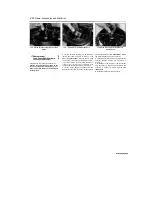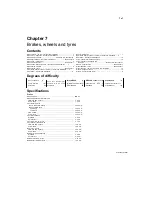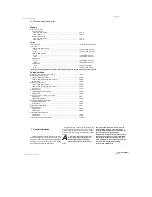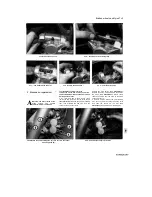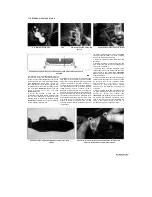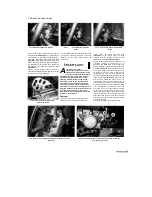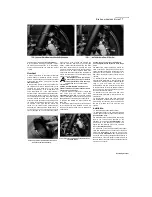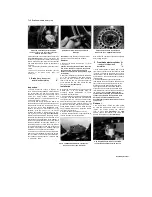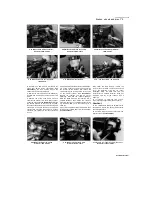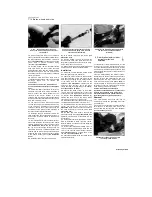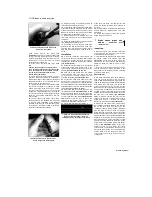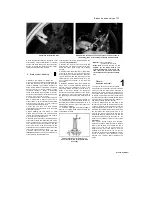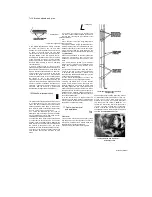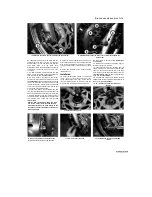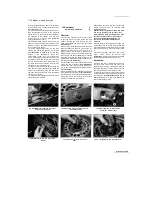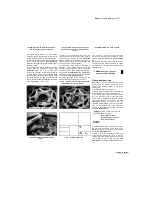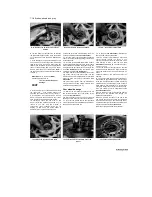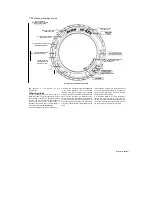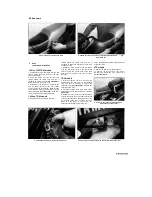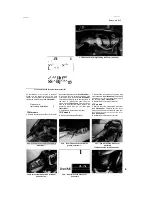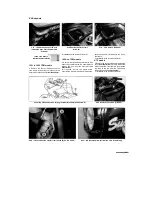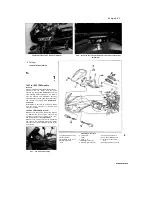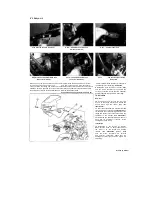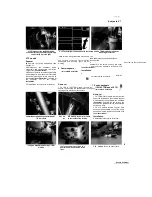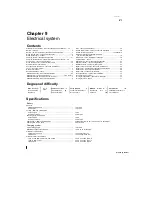
7»14 Brakes, wheels and tyres
4 The wheels should also be visually inspected
for cracks, flat spots on the rim and other
damage, On cast alloy wheels, look very closely
for dents in the area where the tyre bead
contacts the rim. Dents in this area may prevent
complete sealing of the tyre against the rim,
which leads to deflation of the tyre over a period
of time. If damage is evident, or if runout in either
direction is excessive, the wheel will have to be
renewed. Never attempt to repair a damaged
cast alloy wheel.
5 On XTZ models, check for loose or broken
spokes. Tapping the spokes with a screwdriver is
the best guide to their tension. A loose spoke will
make a dull flat note compared to a tight one.
Loose spokes must be tightened by turning the
nipple at the spoke end In an anti-clockwise
direction. Always check for runout after altering
the tension in any of the spokes. Small
irregularities can be corrected by adjusting the
spokes in the affected area, although a certain
amount of practice is necessary to prevent over-
correction. If the wheel runout continues to be
excessive, take the wheel to a professional
wheel builder for inspection and adjustment.
10 WheeSs - alignment check
I
1
Misalignment of the wheels, which may be due
to a cocked rear wheel or a bent frame or fork
yokes, can cause strange and possibly serious
handling problems. If the frame or yokes are at
fault, repair by a frame specialist or replacement
with new parts are the only alternatives.
2 To check the alignment you will need an
assistant, a length of string or a perfectly straight
piece of wood and a ruler. A plumb bob or other
suitable weight will also be required.
3 In order to make a proper check of the wheels
it is necessary to support the bike in an upright
position, using an auxiliary stand. Measure the
width of both tyres at their widest points. Subtract
the smaller measurement from the larger
measurement, then divide the difference by two.
The result is the amount of offset that should
exist between the front and rear tyres on both
sides.
4 If a string is used, have your assistant hold
one end of it about halfway between the floor and
the rear axle, touching the rear sidewall of the
tyre.
5 Run the other end of the string forward and
pull it tight so that it is roughly parallel to the floor.
Slowly bring the string into contact with the front
sidewall of the rear tyre, then turn the front wheel
until it is parallel with the string. Measure the
distance from the front tyre sidewall to the string
(see
illustration).
6 Repeat the procedure on the other side of the
motorcycle. The distance from the front tyre
sidewall to the string should be equal on both
sides.
7 As was previously pointed out, a perfectly
straight length of wood may be substituted for the
string (see illustration). The procedure is the
same.
8 If the distance between the string and tyre is
greater on one side, or if the rear wheel appears
to be cocked, refer to Chapter 1, Section 1 and
check that the chain adjuster markings coincide
on each side of the swingarm.
9 If the front-to-back alignment is correct, the
wheels still may be out of alignment vertically.
10 Using the plumb bob, or other suitable
weight, and a length of string, check the rear
wheel to make sure it is vertical. To do this, hold
the string against the tyre upper sidewall and
allow the weight to settle just off the floor. When
the string touches both the upper and lower tyre
sidewalls and is perfectly straight, the wheel is
vertical. II it is not, place thin spacers under one
leg of the auxiliary stand.
11 Once the rear wheel is vertical, check the
front wheel in the same manner. If both wheels
are not perfectly vertical, the frame and/or major
suspension components are bent.
11 Front wheel-removal
and installation
3t
Removal
1 Position the motorcycle on an auxiliary stand
and support it under the crankcase so that the
front wheel is off the ground. Always make sure
the motorcycle is properly supported.
2 Remove the brake caliper mounting bolts
10.7 Wheel alignment check using a
straight-edge
and slide the calipers off the discs (see Section
3). Support the calipers with a piece of wire or a
bungee cord so that no strain is placed on the
hydraulic hoses. There is no need to disconnect
the hoses from the calipers.
Note:
Do not
operate the front brake lever with the calipers
removed.
3 On TRX, XTZ and 1991 to 1998 TDM
models, unscrew the knurled ring securing the
speedometer cable to the drive gear and detach
the cable
(see illustration and 11.5).
11.3 Unscrew the ring (arrowed)
i
detach the cable
Staned by Stalker
Fix atrtng here
___
L
String hew taut
Check for contact here
10.5 Wheel alignment check using string

